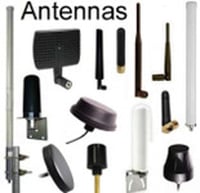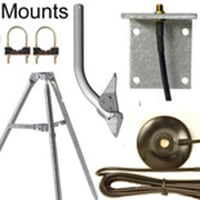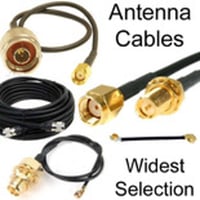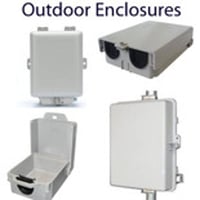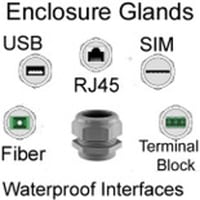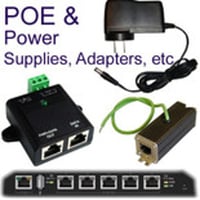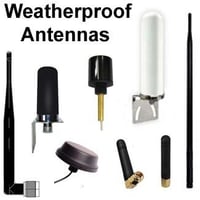USB Cables & Adapters
USB Connector Types:
USB Type A - The type A is also known as the Standard A connector and it is typically a rectangular flat USB connector. It is the pioneering standard for USB connectors and hence it is one of the most commonly used and most recognizable. It is primarily used for data transfer and is used in TVs, gaming consoles, and other host controllers and hubs.
USB Type B - This is a square connector that is distinctive for its slanting corners on the connector ends. The USB is an upstream connector and is most commonly used to connect with peripheral devices such as external hard drives, a phone, or a printer.
USB Type C - This is the newest standard connector that has more power and better transfer rates than the previous USB standards. The C Type can be used for both charging and data transfer, and also supports four-channel audio and DisplayPort video. Since it is reversible, it is compatible with many modern devices including the Nintendo Switch, Pixel phones, MacBook, and many new smartphones, and laptops.
Micro USB – Similar to the Mini USB it has five pins though it is smaller and thinner than all of the other USBs. Since it has a fifth operative pin it can function as a standard connector for both power and data transfer. It supports 480 Mbps speed transfers and hence it is used in modern devices such as digital cameras, PDAs, GPS units, and cell phones and other mobile devices.
Mini-USB - Rarely used as of 2019. This is a connector that is smaller than the standard USB connectors type A, B, and C. It was the standard before the Micro USB and is easily distinguishable by its five pins (one is not functional) and the double thickness as compared to the Micro USB. They are generally used for one purpose, either connecting power or data transfer. They are mainly used in USB hubs, external drives, and digital cameras.
Lightning - Technically not a USB standard though it is the proprietary USB connector on some Apple devices that were manufactured from September 2012. Lightning can be used to transfer data, audio, video, and charging. It is used on devices such as the AirPods, the iPad, and the iPhone among others.
USB Cables and Adapters (Universal Serial Bus) cables are mostly used to:
- Connect computers to peripheral gadgets such as camcorders, scanners, cameras, projectors
- Connect AC/DC charging adapters to tablets and smartphones.
USB cables come in varying shapes and sizes. Both the USB 3.0 and USB 2.0 cables come in lengths up to 14FT (unless they have a repeater), with various connector types used to connect to peripherals and smartphone devices. The connector types include Micro-B, A to A, A to B, USB On-The-Go and Mini-B connectors.
USB Cables Distance Limitations
USB cables have a limitation of 14FT, unless a repeater is built-in to the cable. USB extension cables that have a repeater built-in (at intervals of 10FT to 15FT) are called Active USB Cables. Active USB extension cables can be chained together, up to a total length of 80FT.
As their length increases, USB cables lose their ability to carry signal and power. This includes Active USB cables: The longer the chain of Active USB extension cables, the more likely the total chain will lose its ability to carry signal and/or DC power effectively.
Active USB Extension Cables Overcome Distance Limitation
- USB extension cables help us to overcome the connectivity and distance limitations imposed by USB Cables. A Standard USB cables have a restriction of 5 meters (or about 16 feet and 5 inches). If you want to go beyond this limitation, you can use an Active USB extension cable as the solution.
- Active USB cables have a repeater(s) that enable lengths up to 80 feet. Active USB cables can be chained together up to 196 feet which is around four active extension cables. However, even with the convenience of extending peripheral device it offers, you need to be careful to avoid losing crucial data or damaging your USB device.
- Active USB extension cables do not enable the DC power to be extended up to the total length of the Active USB cable chain. When using this setup, you have to observe cautiousness because you increase the chance of loss of signal and ability to carry DC power-current also diminishes with the length of USB cable.
USB Adapters
These are adapters or short USB cables that are used to convert among different USB cable types, and make them compatible with each other or different USB ports. They have a different USB connector-type at each end, or if the same USB connector is used at each end, they are called "USB Gender Changers."
- A USB adapter is a device that performs the function of a protocol converter between two devices where one device utilizes the proprietary Universal Serial Bus (USB) protocol. This facilitates efficient, effective and convenient communications between the devices.
- The Universal Serial Bus protocol is a key electronics industry standard that oversees the specifications for specific classes of cables and connectors. It was developed in 1996 as a collaborative effort between Compaq, Nortel, IBM, and others. The term 'bus' incidentally relates to a system for data transfer between computers or the components within a single computer.
- The USB standard covers the protocol for connection, communication, and power for computers and peripheral devices in a hierarchical manner and has had four generations so far, each with increasing rates of data transfer.
It was created to standardize and simplify the connection of peripherals to computers and is self-configuring and hot-pluggable, characteristics that make it extremely convenient for both industry and consumer use.
By connecting a USB adapter, devices become interoperable as the protocols of the alternately networked device are converted to the USB protocol for use and vice versa. The relevant protocols for both the computer and peripheral are stored on routers which can convert the transmitted data. The conversion process includes the transfer or translation of data formats and data rates to comply with USB.
USB adapters have a number of key functions that initially arose from their primary purpose of standardizing the connection of peripherals to computers. The USB connector end of an authentic USB adapter will bear the USB logo, signifying that the adapter has cleared compliance testing and that it will work as expected.
USB to serial port adapter.
This adapter converts the serial port, a serial communication interface that has sequential data transfer, one bit at a time. It is a predecessor to USB and is typically used for:
- Modems
- Screens and terminals
- Other peripheral devices
The serial port typically complies with the RS-232 protocol, also known as Recommended Standard 232. This standard has existed since the 60s and oversees serial communication data transmission.
Because it is simple and cheap with little necessary supporting software, the serial port is still in use in a wide range of peripheral hardware and devices including:
- EPoS hardware and peripherals
- Automation equipment
- Testing and Measurement equipment
- Networking hardware and cabling
- Screens and Projectors
A USB to serial port converter facilities compatibility. USB adapters also exist for RS-485 and 422 which have predominantly industrial applications.
USB Adapters for DC power supply
USB routinely facilitates downstream power transfer in a host and connected device relationship. The transfer of electrical current is unidirectional, unlike data transfer which is bidirectional.
There are 3 key classes of downstream USB port that accommodate charging:
- Standard Downstream Port (SDP) operates at 0.1A to 0.5A and is the type of charging port on computers and laptops.
- Downstream Port (CDP) carries DC current at up to 1.5A
- Dedicated Charging Ports (DCP) include wall sockets that carry an in-built USB power adapter and power modules which transfer current at a rate greater than 1.5A for active charging of devices
USB power delivery is supplied typically at 5 volts with a 5% variance. Pins within a USB connector transfer data (D+ and D-) and externalized pins carry current. Each pin is connected to a wire, with four wires in a USB charging cable. The higher specification USB 3.0 carries an additional 5 pins for even faster charging. Mains charging via a USB adapter requires conversion of mains voltage to the standard 5V.
Multiple devices can be charged simultaneously via the USB ports, though the charging will be at a sub-optimal rate. Higher specification 'superspeed' USB is able to adequately handle a greater amount of load and charge multiple devices quickly.
USB Hubs: An Overview
A USB hub is a device with multiple USB ports and connects to a computer USB port to increase the number of USB ports available. USB hubs save you from the constant struggle of plugging and unplugging USB devices if you have a shortage of USB ports.
Other than increasing the number of USB ports the other common uses of USB hubs include:
- Provide a powering mechanism to USB devices
- Allows simultaneous access and use of multiple USB devices
- Allows convenient usage of shared devices such as printers
USB hubs can distribute DC power to multiple devices' USB ports with a collective consumption load of 500 mA. This amount is distributed among the connected devices which means they must have low to average power consumption. Devices that need more than 500 mA or higher than 5 volts must have their power. If your primary use of a USB hub is to charge devices, a multi-port wall adapter can be a better alternative for you.
USB hubs can effectively connect multiple devices to a peripheral especially when sharing peripherals such as scanners and printers. This eliminates the need to move the peripheral device regularly from one computer or place to another.

